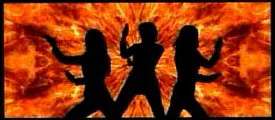![]()
Islam: Truth or Myth?
start page

Allah's Daughters:
"Daughter-gate": Allah's Daughters: el-Lat, el-Uzza, and Manat
|
|
Islam: Truth or Myth? start page |
|
|
|
|
|
|
|
Allah's Daughters: |
|
![]() Historical notes:
Historical notes:
Exactly what are the Satanic verses:
|
Here is how the Koran once read with the satanic verses: |
Here is how it reads today in the Koran: |
|
Near it is the Garden of Abode. Behold, the Lote-tree was shrouded (in mystery unspeakable!) (His) sight never swerved, nor did it go wrong! For truly did he see, of the Signs of his Lord, the Greatest! Have ye seen Lat. and 'Uzza, And another, the third (goddess), Manat? |
Near it is the Garden of Abode. Behold, the Lote-tree was shrouded (in mystery unspeakable!) (His) sight never swerved, nor did it go wrong! For truly did he see, of the Signs of his Lord, the Greatest! Have ye seen Lat. and 'Uzza, And another, the third (goddess), Manat? |
|
These are the exalted cranes (intermediaries) Whose intercession is to be hoped for. |
[Words of Satan Deleted] |
|
What! for you the male sex, and for Him, the female? Behold, such would be indeed a division most unfair! (an-Najm 53:19-22) |
What! for you the male sex, and for Him, the female? Behold, such would be indeed a division most unfair! (an-Najm 53:19-22) |
Here two passages in the Koran that comment on Muhammad's "daughters-gate" scandal:
Like King David of the Bible admonishing himself of his own adultery in Psalms 51, Muhammad discusses the "Satanic verses"
What scholars say about Allah's Daughters:
Written by Brother Andrew